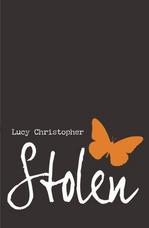 Stolen by Lucy Christopher
The Chicken House, 2010
On a trip to Vietnam with her parents, 16-year-old Gemma meets an attractive and vaguely familiar guy in a Bangkok airport cafe. What she thinks is an innocent flirtation quickly turns into a drug-induced blur that ends when she wakes up on a bed in a small room a few days later. It turns out that she's been taken to a remote part of the vast Australian desert and her captor, Ty, intends to keep her there with him forever.
Stolen is written as a letter from Gemma to Ty as she looks back on the beginning and development of their relationship, so as a reader I spent time in Gemma's head as the kidnapping and subsequent events occur but with the buffer of a reflective distance. This distance has an ebb and flow to it and while some events are told almost like a narrative, others are very immediate. To Lucy Christopher's credit, I didn't notice this flux as I was reading and was simply drawn deeply into the story.
What I find remarkable about Stolen is how the author managed to keep tensions high even when not much is happening. True, Gemma makes some dramatic escape attempts, but for the most part she is watching Ty's movements and slowly absorbing the situation she finds herself in. I found myself turning pages quickly to find out what happens next, and small things (like feeding the chickens) took on a lot of significance as a result.
Gemma's emotional journey throughout the book is wonderfully depicted. Her thoughts and feelings are on display and her actions reflect those internal struggles. Her relationship with Ty develops and his motivations and history are slowly revealed, and he is not in any way a cookie-cutter character. Both Gemma and Ty have a lot of dimension and complexity, and the stark and brutal Australian desert setting is a character in its own right.
My one criticism is that the end felt weak to me and almost like a cop-out (I won't spoil it for you though). I discussed this with a friend of mine who had recommended Stolen to me, and she made the considered point that it was the only possible conclusion. I beg to differ, however, and I feel like the book could have ended far more ambiguously. I will say that Gemma's emotional reactions at the end of the book were consistent and realistic, which I greatly appreciated.
While I've read a few books about teen kidnappings, this one has twists and complexities that I had not yet encountered.
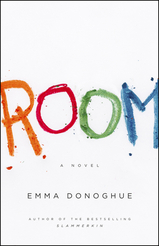 Room by Emma DonoghueLittle, Brown and Company, 2010The winner of a 2011 Alex Award as a book written for adults that has appeal for teens, Room is certainly not for the faint of heart.Jack has just turned five. He and his Ma live in Room, a fortified soundproofed outbuilding where his mother has been kept prisoner for seven years by Old Nick. Although Old Nick is Jack's father, Jack has never laid eyes on him as he visits only at night after Jack has gone to sleep in the wardrobe. Things take a turn for the worse shortly after Jack's birthday and Ma begins to make plans for escape, involving a reluctant Jack who can hardly get his head around the fact that a world exists outside Room, where he is happy and content. Room is told entirely through Jack's eyes, which makes for a fascinating perspective on both the situation he is in and how his mother reacts. As he doesn't know anything different, to him Room is as good as it gets. His perception of television is that it is transmitted from other worlds, and he truly believes that Dora the Explorer is his friend. Despite his naivete Jack is intelligent and is skilled at language. It is actually quite astonishing how diligent Ma has been in trying to keep him physically and mentally healthy in Room. Ma was young when she was kidnapped by Old Nick, and after seven years of captivity she is still only in her mid-twenties. She finally reaches her breaking point when Old Nick shuts off their power and heat for a few days and begins planning their escape. Jack trying to get his head around the outside world is an interesting process, and certainly Donoghue had her work cut out for her narrating from a five-year-old's perspective. There isn't much action in this novel, but what action there is I found extremely suspenseful. Room is far more about character and what people do to survive trauma, and seeing Ma struggle with newfound freedom and Jack trying to make some sense of the world outside Room - as well as the fact that he may sometimes be farther than a few feet away from Ma - was poignant. I believe that older teens will find much to capture their attention here, especially as Ma was a teen when she was kidnapped. Certainly not a light read, it will undoubtedly continue to engender discussion.
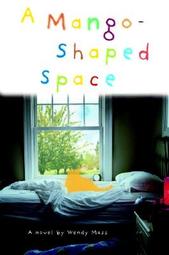 A Mango-shaped space by Wendy MassLittle, Brown, 2005For her entire life, 13-year-old Mia has seen colours and shapes that nobody else can. For Mia, every noise, letter, and number has a specific colour and shape. In fact, she didn't name her cat Mango because of his orange eyes, but because his purr is the same orange colour as the flesh of a mango. It sounds like magic, but ever since the day in third grade when she wrote numbers on the blackboard in their correct colours and was called a freak by classmates, she has kept this a secret and tried her best to be "normal." When she starts failing her algebra and Spanish classes because the colours she sees make it difficult for her to understand, Mia tells her family. After seeing a doctor and a psychotherapist, Mia finally meets someone who can tell her what she needs to know: that she has something called synesthesia and she's not the only one. This opens a whole new world to Mia, but unfortunately there are prices to pay. My initial impression of A Mango-shaped space was that Mia's voice was too old for someone who is 13. While I felt that Wendy Mass's descriptions of the colours and shapes Mia sees were very effective and put me inside her head, the occasional phrase in the first couple of chapters would take me out of the story. I just couldn't imagine Mia actually saying of her older sister "[she] dropped me like a bag of piping-hot microwave popcorn" (p. 7). Fortunately, this impression only applied to the early, more descriptive chapters and soon I was swept up in Mia's experience. This is essentially a coming-of-age book that addresses friendship, a first kiss, family relationships, and grief. However, it is framed within Mia's discovery of synesthesia and figuring out how to deal with it and people's reactions to it and the fact that she kept it a secret for so long. It was remarkable how Wendy Mass described Mia's experience of synesthesia throughout the book, and it certainly increased my understanding of a rare and not often spoken-of human condition.
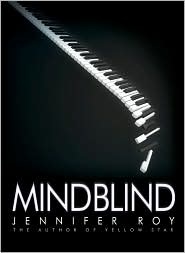 Mindblind by Jennifer RoyMarshall Cavendish, 2010Nathaniel is fourteen years old, enjoys video games and The Amazing Race, and plays keyboards in a band with his best friend and the girl he adores. He is also a homeschooled university graduate, very skilled at mathematics, and has Asperger syndome. Nathaniel's life goal is to be an official genius, which is what many people consider him to be due to his incredible memory and knowledge. However, according to a book he read when he was seven years old, someone must "accomplish something outstanding" (p. 14) before he or she can be considered a genius, so Nathaniel is determined to meet that objective as soon as he can. It remains to be seen if life will get in the way of his goal, and how he might manage to achieve it. Nathaniel has a typically complex teenage life: a girl he secretly has a crush on, divorced parents, not getting along with his father, and an embarrassing episode at a party. On top of that, he struggles to communicate with his family and friends due to his difficulty interpreting social cues, but he is an eminently likable person and quite self-aware. I enjoyed seeing the world from Nathaniel's perspective. The supporting characters have a lot going on as well. Nathaniel's mother was a highlight for me, and her interactions with Nathaniel were kind, firm, and she often exhibited a sense of humour. In many ways, Nathaniel's father is the villain of the book in that he steadfastly refuses to try to relate to Nathaniel in a manner that is outside his comfort zone or expectations. The developing relationships that Nathaniel has with his father's wife and his four-year-old half-brother were lovely to observe, and Nathaniel's best friend Cooper was solid as a rock. So many people in Nathaniel's life were supportive of him and his gradual awareness of this was heartwarming. Author Jennifer Roy has taken her experiences with her son (who, according to her website, also has Asperger syndrome and his highly gifted) and as a teacher and woven them into Mindblind. Thoughtful, humourous, illuminating, and highly recommended.
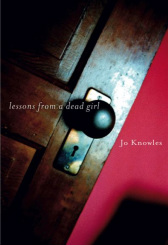 Lessons from a dead girl by Jo Knowles
Candlewick, 2007
Beautiful, popular Leah takes awkward Laine under her wing when they are in fifth grade and declares them to be friends forever. Laine is confused by the attention but happily goes along with it. Laine even goes along with Leah's insistence that they secretly "practice" for marriage together, although Laine becomes increasingly confused by what it means about her relationship with Leah. While the girls grow apart as they enter high school, Leah maintains a powerful hold over Laine until a public confrontation results in tragedy.
Knowles tackles the topic of sexual abuse between children head-on, and she does it with a remarkably delicate touch while pulling no punches. Laine's confusion and desperation to keep Leah happy, as well as the tension between Laine and Leah in the years after their "practice" ends, are well-rendered. Although there are certainly scenes that are uncomfortable as a reader, nothing is graphically presented and the narrative focuses primarily on the emotions of the characters, especially Laine as the novel is from her point of view.
Leah and Laine are three-dimensional characters with specific and evident motivations, and their respective evolutions as they grow into teenagers are unsurprising but nonetheless poignant. Although I know very little about this topic, it would appear that the author did a good deal of research to create such believable characters, and this novel was an emotional and educational introduction to the subject and will not soon be forgotten.
|





 RSS Feed
RSS Feed